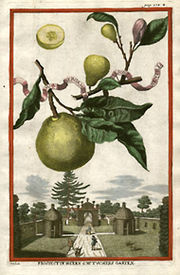
Johann Christoph Volkamer
Encyclopedia

Germans
The Germans are a Germanic ethnic group native to Central Europe. The English term Germans has referred to the German-speaking population of the Holy Roman Empire since the Late Middle Ages....
merchant, manufacturer and botanist.
Life
Johann Christoph Volkamer (also: Volcamer, Volckamer, Volkammer, Volcameris) was the son of the physician Johann George Volkamer. He was occupied by hobby with the botany and maintained a garden in the today's NurembergNuremberg
Nuremberg[p] is a city in the German state of Bavaria, in the administrative region of Middle Franconia. Situated on the Pegnitz river and the Rhine–Main–Danube Canal, it is located about north of Munich and is Franconia's largest city. The population is 505,664...
ian Gostenhof district. He published 1708-1714 a two volume work over citrus
Citrus
Citrus is a common term and genus of flowering plants in the rue family, Rutaceae. Citrus is believed to have originated in the part of Southeast Asia bordered by Northeastern India, Myanmar and the Yunnan province of China...
under the title "Nurenbergische Hesperides, the thorough description of the noble Citron
Citron
Not to be confused with Cintron.The citron is a fragrant citrus fruit, botanically classified as Citrus medica by both the Swingle and Tanaka systems...
, used in within and neighbouring area, praised Lemon
Lemon
The lemon is both a small evergreen tree native to Asia, and the tree's ellipsoidal yellow fruit. The fruit is used for culinary and non-culinary purposes throughout the world – primarily for its juice, though the pulp and rind are also used, mainly in cooking and baking...
, and Orange
Orange (fruit)
An orange—specifically, the sweet orange—is the citrus Citrus × sinensis and its fruit. It is the most commonly grown tree fruit in the world....
fruits, like such, be received and carried away, velvet of a detailed dicription of most sorts, which some were brought to Nuremberg actually grown, others by different strange places there... "
In Volkamers time one saw the "Goldenen of apples in the citrus fruits Hesperides
Hesperides
In Greek mythology, the Hesperides are nymphs who tend a blissful garden in a far western corner of the world, located near the Atlas mountains in North Africa at the edge of the encircling Oceanus, the world-ocean....
" the Greek mythology
Greek mythology
Greek mythology is the body of myths and legends belonging to the ancient Greeks, concerning their gods and heroes, the nature of the world, and the origins and significance of their own cult and ritual practices. They were a part of religion in ancient Greece...
. Starting from late 17th Century developed a collecting passion for instance at the aristocracy, with which each tried to exceed the other one with the rarest and monsterious fruits.
With this work the term became "Hesperides" to the symbol for the flowering Nurembergian garden culture, those for instance lasted from 1650 on, up to the end 18th Century.
In Volkamers book he illustrated also Nurembergian landscapes, city opinions and above all gardens of the city, become in beside the Citrus plants and their fruits illustrated by engraving
Engraving
Engraving is the practice of incising a design on to a hard, usually flat surface, by cutting grooves into it. The result may be a decorated object in itself, as when silver, gold, steel, or glass are engraved, or may provide an intaglio printing plate, of copper or another metal, for printing...
.
He is said to be influenced from the work of Giovanni Baptista Ferrari
Giovanni Baptista Ferrari
Giovanni Baptista Ferrari , was an Italian Jesuit and professor in Rome, a botanist, and an author of illustrated botanical books and a Latin-Syrian dictionary....
.
Works
- Nürnbergische Hesperides, Oder Gründliche Beschreibung Der Edlen Citronat- Citronen- und Pomerantzen-Früchte..., Nürnberg 1708, Nachdruck Zirndorf 1978.
- Obeliscus Constantinopolitanus oder kurtze Erklärung des zu Constantinopol auf der Renn-Bahn stehenden, nun aber auch in der nürnbergischen Vorstadt Gostenhof nachgehauenen und aufgerichteten Obelisci, Nuremberg 1713, Nachdruck Nuremberg 1985.
- http://digi.azz.cz/bookinfo.php?BookID=22&lng=2Continuation der Nürnbergischen Hesperidum, Oder Fernere gründliche Beschreibung der edlen Citronat-, Citronen- und Pomerantzen- Früchte, mit einem ausführlichen Bericht, wie solche am besten zu warten und zu erhalten seyn; woher diejenigen Sorten, so theils in Nürnberg gewachsen, theils von verschiedenen fremden Orten dahingelangt..., Nuremberg 1714.]
Literature
- Wilhelm Schwemmer: Johann Christoph Volkamer, in: Nürnberger Gestalten aus neun Jahrhunderten, Nuremberg 1950, 135-139.
- Helge Weingärtner: Nürnbergische Veduten in J.C. Volkamers Hesperidenwerk, Magisterarbeit Universität Erlangen 1990.
- Christian Jörg Zink: Ein Meisterstück der Gartenkunst. Der Garten der Familie Volkamer, in: Katrin Bielefeldt, u.a.: Gostenhof, Muggenhof, Eberhardshof und Kleinweidenmühle. Geschichte eines Stadtteils (Nürnberger Stadtteilbücher 9, hg. von Geschichte Für Alle e.V.), Nuremberg 2005, 44-49.
- Michael Diefenbacher, Rudolf Endres (Hrsg.): Stadtlexikon Nürnberg. 2. verb. Auflage. Nürnberg: Verlag W. Tümmels, 2000, 1247 S., ISBN 3-921590-69-8.

